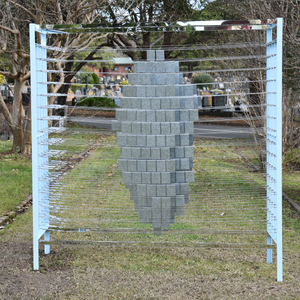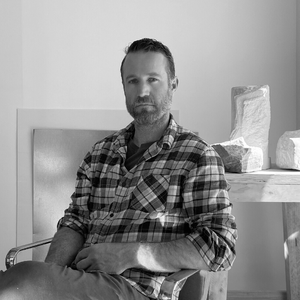Aura Reader (2021)
Mild steel, galvanised steel, wire cable

Aura Reader is a sculpture that acts as a kind of tool or instrument to read the aura of its site at Rookwood. The sculpture’s faceted form references crystal gazing and aura readings popularised by the Victorian Spiritualist movement which flourished in the late 1800s when Rookwood Cemetery was founded. It also evokes the original Greek meaning of the word ‘aura’ which translates as breeze or breath; as its panels ripple in the spring wind it embodies the ephemeral airways of Rookwood cemetery.
About the Artist

Niall Robb lives on Ngunnawal and Walbunja Country in the NSW Southern Tablelands. He is an interdisciplinary artist whose work investigates materiality, surface phenomena and visual trickery. More recently Niall’s work has responded to his experience of building an off-grid studio, developing an affinity for DIY building materials and processes and incorporating them into his practice. His work has been featured in numerous prizes and exhibitions in Sydney including the David Harold Tribe Sculpture Award, Redlands Konica Minolta Art Prize and New Contemporaries at Sydney College of the Arts.
Transcription
Hi, my name is Niall Robb and the work that I'm including in HIDDEN 2022 is titled Aura Reader.
Aura Reader is a large scale outdoor sculpture which interacts with the winds and light of Rookwood Cemetery. It's made up of hundreds of individually hinged galvanized steel panels suspended between two metal frames arranged in a geode or crystal act shape. The panels themselves have a crystalline or spangled texture. This texture is created when the steel panels are hot dipped into malt and zinc. I was really drawn to this surface effect and have aims to highlight this through the sculptures interaction with the elements at Rookwood.
I guess conceptually, the work aims to function as a kind of tool or instrument which reads the aura of the side at Rookwood, tapping into the original Greek meaning of the word aura, which lets really translates as breeze or breath. So originally, after visiting the site, I went through a process of sketching the work up by hand and then I moved on to sketch up just to get a sense of the scale and the form of the work.
After that I was able to work out how many panels would be needed to create the effect. At this stage I also had to figure out the most elegant way to attach the panels to the wiring, and I decided that folding themselves would be the most effective. Then I had the individual panels laser cut to size and then I welded the frame structures and finally had them powder coated, and then I installed the work on site.
When presented with the themes of Rookwood, it's hard to avoid notions of spirituality and belief, so I looked into the history of the cemetery, its roots in the late 1800s. At the same time, I was really drawn to the crystallite forms of galvanized steel, which I first noticed when building a steel frame studio with my partner a few years ago, and I think the ideas really started coming together, tying in notions of Victorian spiritualism and aura reading with the way that the sculpture interacts with the site and its elements and how it's distinctive surface qualities map these interactions or, as I'd like the audience to see an otherwise overlooked or utilitarian object like galvanized steel, as something potentially active, responsive or even playful, but also like, in a subtle way, to create a moment in which people are more in tune with the site of Rookwood, particularly the light and the wind, or even what we might call the aura of the site.